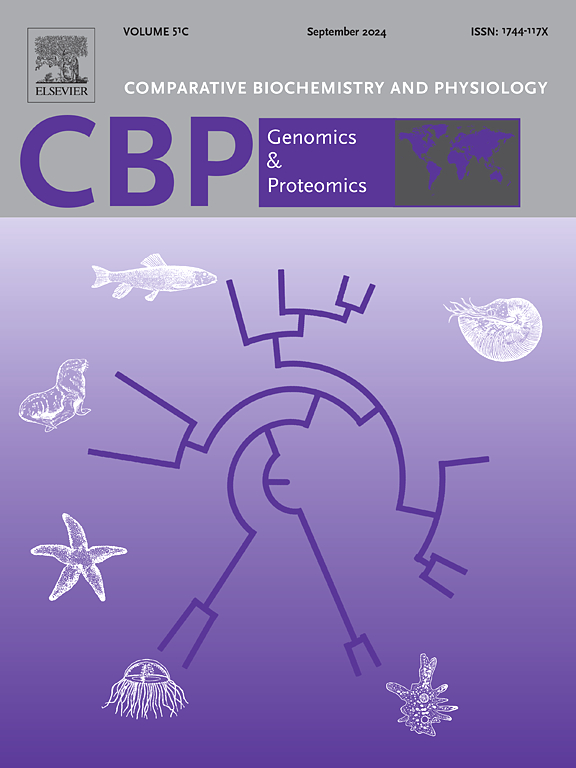Comparative miRNA transcriptome analysis reveals miR-375-3p targets cyp19a and regulates ovarian development in Medaka (Oryzias latipes)
IF 2.2
2区 生物学
Q4 BIOCHEMISTRY & MOLECULAR BIOLOGY
Comparative Biochemistry and Physiology D-Genomics & Proteomics
Pub Date : 2025-05-17
DOI:10.1016/j.cbd.2025.101535
引用次数: 0
Abstract
In teleosts, hormonal secretion from the pituitary gland exhibits significant sex plasticity, potentially linked to gonadal differentiation through the hypothalamic-pituitary-gonadal (HPG) axis. miRNAs, as transcriptional regulators, affecting gene expression by promoting mRNA degradation or suppressing translation. To explore the association between miRNAs and cyp19a and their potential role in reproduction, RNA sequencing (RNA-Seq) was conducted on male and female medaka brains. A total of 54 miRNAs were identified as significantly differentially expressed, with 45 showing female-biased expression and 9 exhibiting male-biased expression. qPCR analysis revealed that the expression levels of candidate miRNAs significantly differed between males and females as sex differentiation progressed. Additionally, cyp19a1a was highly expressed in the ovary, while cyp19a1b showed high expression in the brain. Treatment with the aromatase inhibitor exemestane (EM) induced male characteristics, leading to noticeable ovarian degeneration and cavitation. Following EM treatment, qPCR analysis showed an increase in miRNA expression, alongside a decrease in female development-related genes (foxl2, cyp19a1a, and cyp19a1b) and an increase in male development-related genes (dmy, cyp17a, and gsdf), compared to the control group. Additionally, a dual-luciferase reporter assay confirmed that miR-375-3p specifically binds to cyp19a1a and cyp19a1b. In conclusion, this study enhances the understanding of miRNA regulatory mechanisms in the brain, gonads, and reproductive development of medaka.

比较miRNA转录组分析揭示miR-375-3p靶向cyp19a并调节Medaka (Oryzias latipes)卵巢发育
在硬骨鱼中,垂体分泌的激素表现出显著的性别可塑性,可能通过下丘脑-垂体-性腺(HPG)轴与性腺分化有关。mirna作为转录调控因子,通过促进mRNA降解或抑制翻译来影响基因表达。为了探索miRNAs与cyp19a之间的关联及其在生殖中的潜在作用,我们对雄性和雌性medaka大脑进行了RNA测序(RNA- seq)。共有54个mirna被鉴定为显著差异表达,其中45个表现出女性偏向性表达,9个表现出男性偏向性表达。qPCR分析显示,随着性别分化的进展,候选mirna的表达水平在雄性和雌性之间存在显著差异。此外,cyp19a1a在卵巢中高表达,而cyp19a1b在大脑中高表达。用芳香酶抑制剂依西美坦(EM)治疗诱导男性特征,导致卵巢明显变性和空化。EM治疗后,qPCR分析显示,与对照组相比,miRNA表达增加,女性发育相关基因(foxl2, cyp19a1a和cyp19a1b)减少,男性发育相关基因(dmy, cyp17a和gsdf)增加。此外,双荧光素酶报告试验证实miR-375-3p特异性结合cyp19a1a和cyp19a1b。总之,本研究增强了对medaka脑、性腺和生殖发育中miRNA调控机制的理解。
本文章由计算机程序翻译,如有差异,请以英文原文为准。
求助全文
约1分钟内获得全文
求助全文
来源期刊
CiteScore
5.10
自引率
3.30%
发文量
69
审稿时长
33 days
期刊介绍:
Comparative Biochemistry & Physiology (CBP) publishes papers in comparative, environmental and evolutionary physiology.
Part D: Genomics and Proteomics (CBPD), focuses on “omics” approaches to physiology, including comparative and functional genomics, metagenomics, transcriptomics, proteomics, metabolomics, and lipidomics. Most studies employ “omics” and/or system biology to test specific hypotheses about molecular and biochemical mechanisms underlying physiological responses to the environment. We encourage papers that address fundamental questions in comparative physiology and biochemistry rather than studies with a focus that is purely technical, methodological or descriptive in nature.

 求助内容:
求助内容: 应助结果提醒方式:
应助结果提醒方式:


